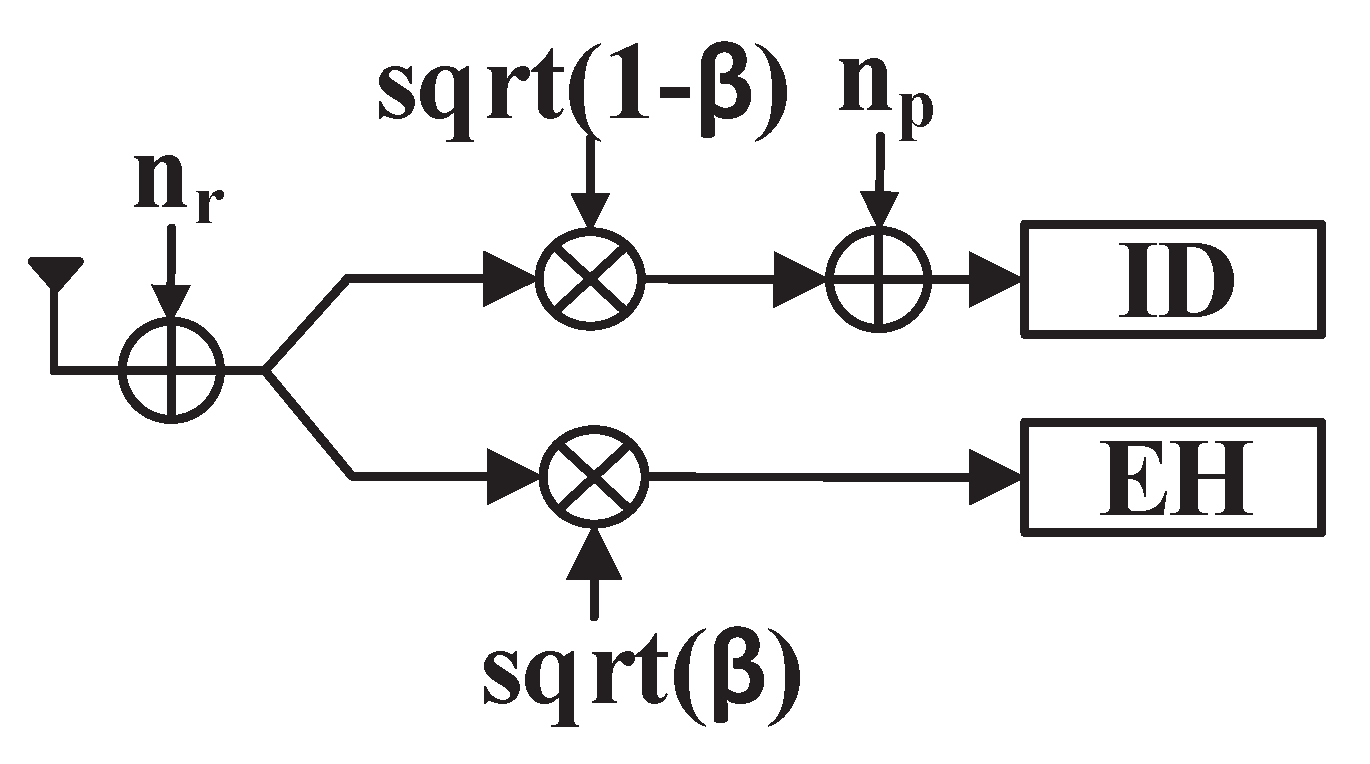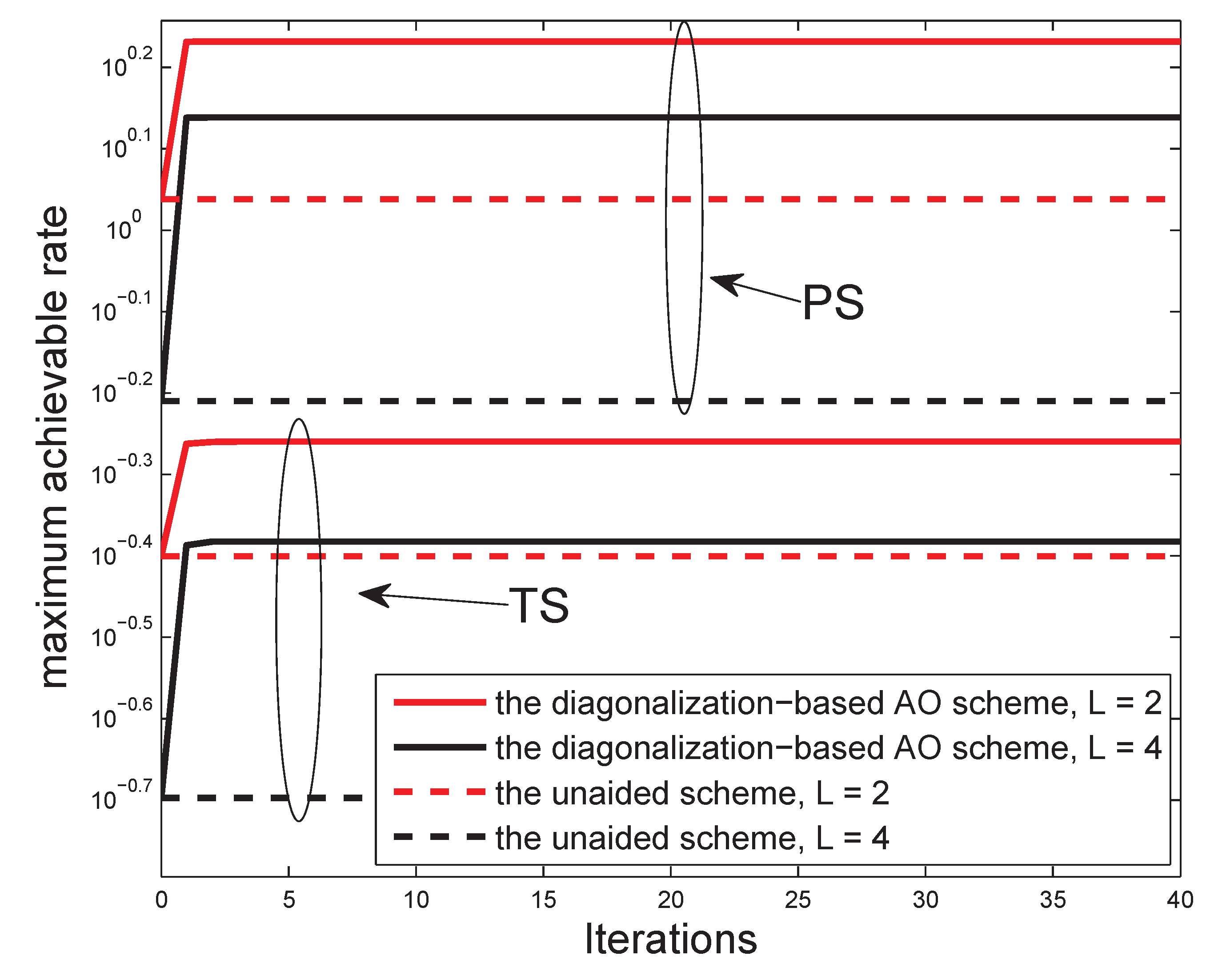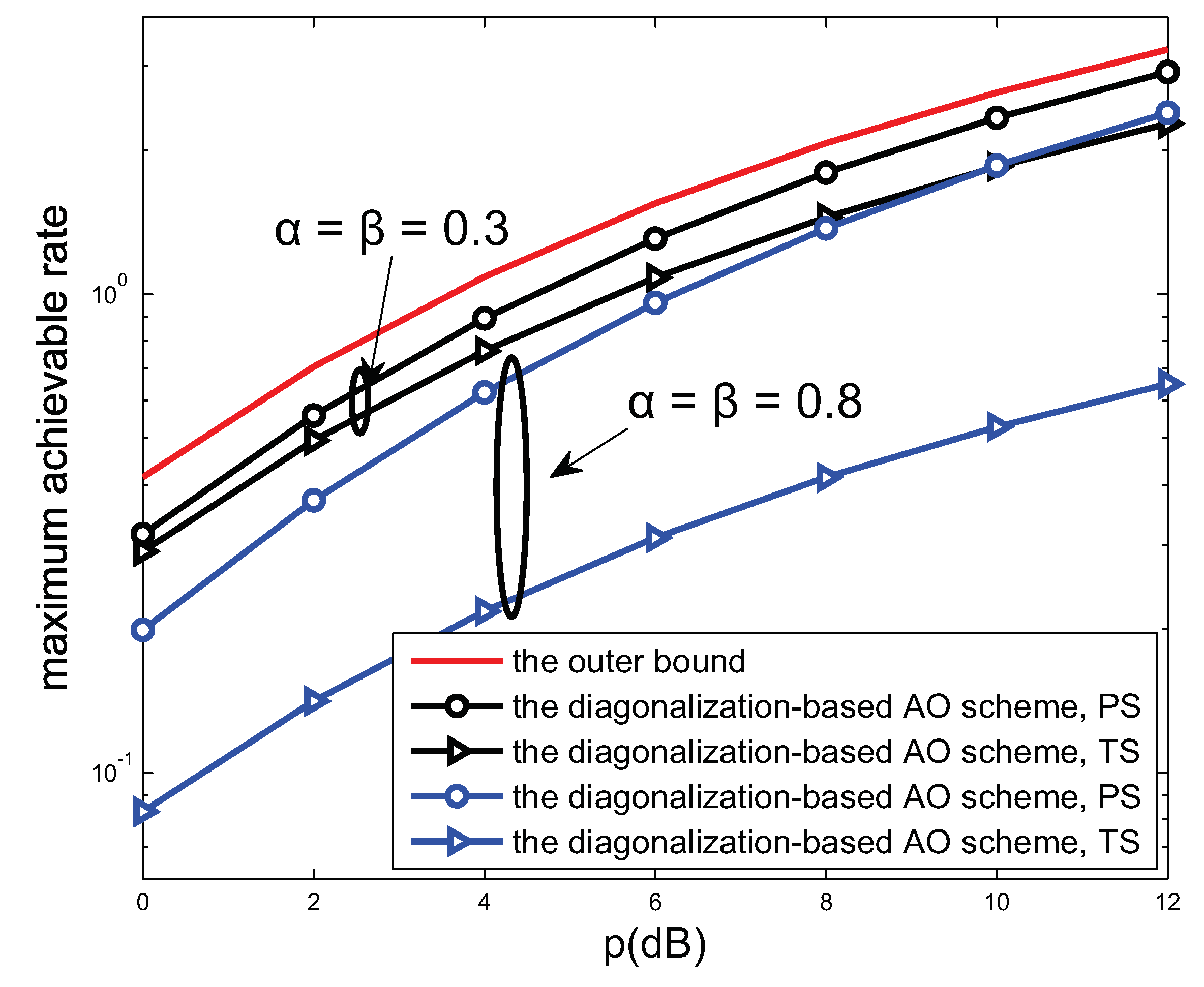Joint Source and Relay Beamforming Design in Wireless Multi-Hop Sensor Networks with SWIPT
Abstract
1. Introduction
2. System Model
3. Joint Beamforming Design for PS Protocol
3.1. Problem Formulation
3.2. Scheme Design
4. Joint Beamforming Design for TS Protocol
5. Numerical Results and Disscussion
6. Conclusions
Author Contributions
Funding
Conflicts of Interest
Abbreviations
| WSN | Wireless sensor network |
| SWIPT | Simultaneous wireless information and power transfer |
| RF | Radio-frequency |
| PS | Power splitting |
| TS | Time switching |
| MIMO | Multiple-input multiple-output |
| MSE | Mean-square-error |
| AF | Amplify-and-forward |
| WMSN | Wireless multi-hop sensor network |
| EH | Energy harvesting |
| MAR | Maximum achievable rate |
| AO | Alternating optimization |
| SVD | Singular value decomposition |
| CSI | Channel state information |
| AWGN | Additive white Gaussian noise |
| ID | Information decoding |
| NP-hard | Non-deterministic polynomial-time hard |
| WIT | Wireless information transmission |
References
- Li, S.; Zhou, X.; Wang, C.; Yuan, D.; Zhang, W. Joint Transmit Power Allocation and Splitting for SWIPT Aided OFDM-IDMA in Wireless Sensor Networks. Sensors 2017, 17, 1566. [Google Scholar] [CrossRef] [PubMed]
- Tan, Y.K.; Panda, S.K. Self-Autonomous Wireless Sensor Nodes with Wind Energy Harvesting for Remote Sensing of Wind-Driven Wildfire Spread. IEEE Trans. Instrum. Meas. 2011, 60, 1367–1377. [Google Scholar] [CrossRef]
- Le, T.N.; Pegatoquet, A.; Berder, O.; Sentieys, O. Energy-Efficient Power Manager and MAC Protocol for Multi-Hop Wireless Sensor Networks Powered by Periodic Energy Harvesting Sources. IEEE Sens. J. 2015, 15, 7208–7220. [Google Scholar] [CrossRef]
- Tesla, N. Apparatus for Transmitting Electrical Energy. U.S. Patent 1,119,732, 1 December 1914. [Google Scholar]
- Varshney, L. Transporting information and energy simultaneously. In Proceedings of the 2008 IEEE International Symposium on Information Theory, Toronto, ON, Canada, 6–11 July 2008; pp. 1612–1616. [Google Scholar]
- Krikidis, I.; Timotheou, S.; Nikolaou, S.; Zheng, G.; Ng, D.W.K.; Schober, R. Simultaneous wireless information and power transfer in modern communication systems. IEEE Commun. Mag. 2014, 52, 104–110. [Google Scholar] [CrossRef]
- Liu, X.; Jia, Y.; Wen, Z.; Zou, J.; Li, S. Beamforming Design for Full-Duplex SWIPT with Co-Channel Interference in Wireless Sensor Systems. Sensors 2018, 18, 3362. [Google Scholar] [CrossRef] [PubMed]
- Bi, S.; Ho, C.K.; Zhang, R. Wireless powered communication: Opportunities and challenges. IEEE Commun. Mag. 2015, 53, 117–125. [Google Scholar] [CrossRef]
- Zhang, R.; Ho, C. MIMO broadcasting for simultaneous wireless information and power transfer. IEEE Trans. Wirel. Commun. 2013, 12, 1989–2001. [Google Scholar] [CrossRef]
- Amarasuriya, G.; Larsson, E.G.; Poor, H.V. Wireless Information and Power Transfer in Multiway Massive MIMO Relay Networks. IEEE Trans. Wirel. Commun. 2016, 15, 3837–3855. [Google Scholar] [CrossRef]
- Wen, Z.; Liu, X.; Zheng, S.; Guo, W. Joint Source and Relay Design for MIMO Two-Way Relay Networks with SWIPT. IEEE Trans. Veh. Technol. 2018, 67, 822–826. [Google Scholar] [CrossRef]
- Wen, Z.; Liu, X.; Beaulieu, N.C.; Wang, R.; Wang, S. Joint Source and Relay Beamforming Design for Full-Duplex MIMO AF Relay SWIPT Systems. IEEE Commun. Lett. 2016, 20, 320–323. [Google Scholar] [CrossRef]
- Wang, S.; Xia, M.; Huang, K.; Wu, Y. Wirelessly Powered Two-Way Communication With Nonlinear Energy Harvesting Model: Rate Regions Under Fixed and Mobile Relay. IEEE Trans. Wirel. Commun. 2017, 16, 8190–8204. [Google Scholar] [CrossRef]
- Li, B.; Rong, Y. Joint Transceiver Optimization for Wireless Information and Energy Transfer in Nonregenerative MIMO Relay Systems. IEEE Trans. Veh. Technol. 2018, 67, 8348–8362. [Google Scholar] [CrossRef]
- Boshkovska, E.; Ng, D.W.K.; Zlatanov, N.; Schober, R. Practical Non-Linear Energy Harvesting Model and Resource Allocation for SWIPT Systems. IEEE Commun. Lett. 2015, 19, 2082–2085. [Google Scholar] [CrossRef]
- Clerckx, B.; Zhang, R.; Schober, R.; Ng, D.W.K.; Kim, D.I.; Poor, H.V. Fundamentals of Wireless Information and Power Transfer: From RF Energy Harvester Models to Signal and System Designs. IEEE J. Sel. Areas Commun. 2019, 37, 4–33. [Google Scholar] [CrossRef]
- Shin, K.; Lee, H.; Cho, D. DiBA: Distributed Bottleneck Alleviation Scheme in Wireless Multi-Hop Sensor Networks. IEEE Commun. Lett. 2014, 18, 431–434. [Google Scholar] [CrossRef]
- Mao, M.; Cao, N.; Chen, Y.; Zhou, Y. Multi-Hop relaying using energy harvesting. IEEE Wireless Commun. Lett. 2015, 4, 565–568. [Google Scholar] [CrossRef]
- Rong, Y.; Hua, Y. Optimality of Diagonalization of Multi-Hop MIMO Relays. IEEE Trans. Wirel. Commun. 2009, 8, 6068–6077. [Google Scholar] [CrossRef]
- Yang, C.; Xia, B.; Xie, W.; Huang, K.; Yao, Y.; Zhao, Y. Interference Cancelation at Receivers in Cache-Enabled Wireless Networks. IEEE Trans. Veh. Technol. 2018, 67, 842–846. [Google Scholar] [CrossRef]
- Ding, Z.; Zhong, C.; Ng, D.W.K.; Peng, M.; Suraweera, H.A.; Schober, R.; Poor, H.V. Application of smart antenna technologies in simultaneous wireless information and power transfer. IEEE Commun. Mag. 2015, 53, 86–93. [Google Scholar] [CrossRef]
- Behbahani, A.S.; Merched, R.; Eltawil, A.M. Optimizations of a MIMO Relay Network. IEEE Trans. Signal Process. 2008, 56, 5062–5073. [Google Scholar] [CrossRef]
- Rong, Y.; Tang, X.; Hua, Y. A Unified Framework for Optimizing Linear Nonregenerative Multicarrier MIMO Relay Communication Systems. IEEE Trans. Signal Process. 2009, 57, 4837–4851. [Google Scholar] [CrossRef]
- Taghizadeh, O.; Zhang, J.; Haardt, M. Transmit beam-forming aided amplify-and-forward MIMO full-duplex relaying with limited dynamic range. Signal Process. 2016, 127, 266–281. [Google Scholar] [CrossRef]
- Taghizadeh, O.; Cirik, A.C.; Mathar, R. Hardware Impairments Aware Transceiver Design for Full-Duplex Amplify-and-Forward MIMO Relaying. IEEE Trans. Wirel. Commun. 2018, 17, 1644–1659. [Google Scholar] [CrossRef]
- Benkhelifa, F.; Alouini, M.S. Simultaneous wireless information and power transfer for MIMO amplify-and-forward relay systems. In Proceedings of the 2015 IEEE Global Communications Conference (GLOBECOM), San Diego, CA, USA, 6–10 December 2015; pp. 1–6. [Google Scholar]
- Tarokh, V.; Seshadri, N.; Calderbank, A.R. Space-time codes for high data rate wireless communication: Performance criterion and code construction. IEEE Trans. Inf. Theory 1998, 44, 744–765. [Google Scholar] [CrossRef]
- Wang, R.; Tao, M. Joint Source and Relay Precoding Designs for MIMO Two-Way Relaying Based on MSE Criterion. IEEE Trans. Signal Process. 2012, 60, 1352–1365. [Google Scholar] [CrossRef]
- Boyd, S.; Vandenberghe, L. Convex Optimization; Cambridge University Press: Cambridge, UK, 2004. [Google Scholar]
- Grant, M.; Boyd, S. CVX: Matlab Software for Disciplined Convex Programming. Available online: http://cvxr.com/cvx/ (accessed on 25 December 2018).
- Demir, O.T.; Tuncer, T.E. Antenna Selection and Hybrid Beamforming for Simultaneous Wireless Information and Power Transfer in Multi-Group Multicasting Systems. IEEE Trans. Wirel. Commun. 2016, 15, 6948–6962. [Google Scholar] [CrossRef]
- Mirza, J.; Zheng, G.; Wong, K.; Lambotharan, S.; Hanzo, L. On the Performance of Multiuser MIMO Systems Relying on Full-Duplex CSI Acquisition. IEEE Trans. Commun. 2018, 66, 4563–4577. [Google Scholar] [CrossRef]





© 2019 by the authors. Licensee MDPI, Basel, Switzerland. This article is an open access article distributed under the terms and conditions of the Creative Commons Attribution (CC BY) license (http://creativecommons.org/licenses/by/4.0/).
Share and Cite
Liu, X.; Wen, Z.; Liu, D.; Zou, J.; Li, S. Joint Source and Relay Beamforming Design in Wireless Multi-Hop Sensor Networks with SWIPT. Sensors 2019, 19, 182. https://doi.org/10.3390/s19010182
Liu X, Wen Z, Liu D, Zou J, Li S. Joint Source and Relay Beamforming Design in Wireless Multi-Hop Sensor Networks with SWIPT. Sensors. 2019; 19(1):182. https://doi.org/10.3390/s19010182
Chicago/Turabian StyleLiu, Xiaoqing, Zhigang Wen, Dan Liu, Junwei Zou, and Shan Li. 2019. "Joint Source and Relay Beamforming Design in Wireless Multi-Hop Sensor Networks with SWIPT" Sensors 19, no. 1: 182. https://doi.org/10.3390/s19010182
APA StyleLiu, X., Wen, Z., Liu, D., Zou, J., & Li, S. (2019). Joint Source and Relay Beamforming Design in Wireless Multi-Hop Sensor Networks with SWIPT. Sensors, 19(1), 182. https://doi.org/10.3390/s19010182




